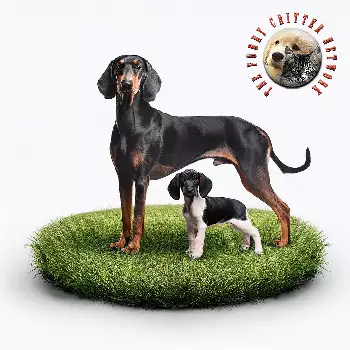The Chien Courant Slovaque generally enjoys good health and respectable longevity, with most individuals living 12-13 years when provided with appropriate care, nutrition, and exercise. The breed benefits from its working heritage, as breeding programs have traditionally emphasized functional soundness and endurance over purely aesthetic considerations. However, like all purebred dogs, certain health conditions occur with some frequency and warrant attention from breeders and owners to maintain overall population health.
Hip dysplasia represents a significant orthopedic concern for the breed, affecting the normal development and function of the hip joint. This hereditary condition causes varying degrees of lameness, pain, and arthritis as affected dogs age. The condition results from genetic factors combined with environmental influences during growth including nutrition, exercise, and growth rate. Responsible breeders screen breeding stock through radiographic evaluation before breeding and select only dogs with acceptable hip scores. While the condition cannot be completely eliminated from any breed, selective breeding significantly reduces incidence over generations.
Elbow dysplasia, though less common than hip dysplasia, also occurs in some individuals and causes similar problems of pain, lameness, and arthritis affecting the front limbs. Like hip dysplasia, this condition has both genetic and environmental components and can be managed through screening breeding stock before they are bred. Von Willebrand's disease, a blood clotting disorder, appears in some bloodlines and causes excessive bleeding from minor injuries or during surgical procedures. Genetic testing identifies carriers and affected individuals, allowing veterinarians to take appropriate precautions during surgeries and breeders to make informed decisions about breeding combinations.
Obesity poses health risks particularly for working breeds when they don't receive adequate exercise to burn calories consumed through diet. Excess weight stresses joints, contributes to orthopedic problems, and can lead to metabolic disorders including diabetes. Maintaining appropriate body condition through portion control and regular exercise prevents obesity-related complications. Bloat or gastric dilatation-volvulus represents a life-threatening emergency that can affect deep-chested breeds like the Slovenský Kopov. This condition occurs when the stomach fills with gas and rotates on its axis, cutting off blood supply and requiring immediate surgical intervention. Feeding multiple small meals daily rather than one large meal, avoiding vigorous exercise immediately after eating, and monitoring for symptoms helps reduce risk.
Ear infections occur with increased frequency in drop-eared breeds due to reduced airflow and moisture retention in the ear canal. Regular cleaning and inspection help prevent infections before they become established. Prompt treatment of infections prevents them from becoming chronic conditions that damage ear structures. Patellar luxation, where the kneecap dislocates from its normal position, can occur in medium-sized breeds and may require surgical correction in severe cases.
Regular veterinary care forms the foundation of health maintenance throughout the dog's life. Annual wellness examinations allow early detection of developing problems before they become serious. Puppies require a series of vaccinations to protect against infectious diseases including distemper, parvovirus, and rabies, with boosters administered according to veterinary recommendations throughout adulthood. Parasite prevention addressing fleas, ticks, and heartworms protects against disease transmission and discomfort, particularly important for dogs that hunt or spend extensive time outdoors.
Health screening tests appropriate to the breed include hip and elbow radiographs on breeding stock before they are bred, preferably through orthopedic foundation evaluations that provide objective assessments. Genetic testing for von Willebrand's disease, hyperuricosuria, degenerative myelopathy, and progressive rod-cone degeneration can identify carriers and affected individuals, allowing breeders to make informed decisions. Prospective puppy buyers should ask breeders about health testing performed on parents and request documentation of results. Selecting puppies from health-tested parents significantly reduces risks of inherited problems, though no breeding program eliminates all health concerns. The breed's working heritage and careful selection for functional soundness contribute to generally good health and working longevity for dogs maintained in appropriate condition throughout their lives.
Common Health Issues
- Hip dysplasia represents a significant orthopedic concern for the breed, affecting the normal development and function of the hip joint.
- Elbow dysplasia, though less common than hip dysplasia, also occurs in some individuals and causes similar problems of pain, lameness, and arthritis affecting the front limbs.
- Like hip dysplasia, this condition has both genetic and environmental components and can be managed through screening breeding stock before they are bred.
- Von Willebrand's disease, a blood clotting disorder, appears in some bloodlines and causes excessive bleeding from minor injuries or during surgical procedures.
- Patellar luxation, where the kneecap dislocates from its normal position, can occur in medium-sized breeds and may require surgical correction in severe cases.
- Genetic testing for von Willebrand's disease, hyperuricosuria, degenerative myelopathy, and progressive rod-cone degeneration can identify carriers and affected individuals, allowing breeders to make informed decisions.
Preventive Care & Health Monitoring
- The Chien Courant Slovaque generally enjoys good health and respectable longevity, with most individuals living 12-13 years when provided with appropriate care, nutrition, and exercise.
- The condition results from genetic factors combined with environmental influences during growth including nutrition, exercise, and growth rate.
- Like hip dysplasia, this condition has both genetic and environmental components and can be managed through screening breeding stock before they are bred.
- Obesity poses health risks particularly for working breeds when they don't receive adequate exercise to burn calories consumed through diet.
Regular veterinary check-ups and preventive care are essential for maintaining your Chien Courant Slovaque's health and longevity.

